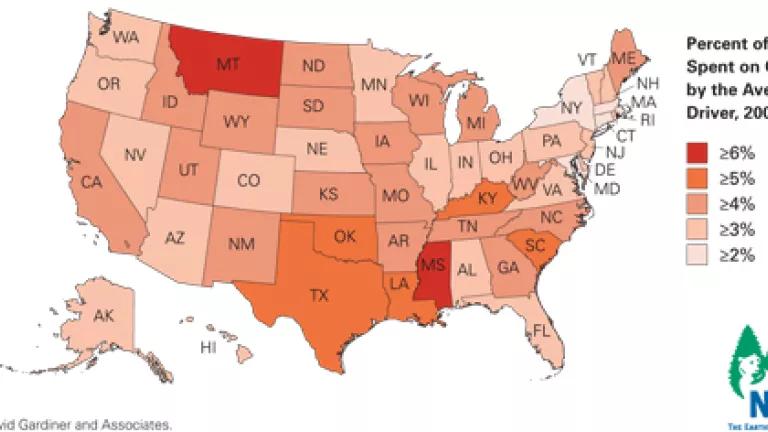
This morning we released our fourth annual report on state oil addiction, which actually consists of two rankings. One focuses on the problem of the economic burden posed by oil dependence in transportation, in which we ranked states based on the average percentage of income their registered drivers had to pay for gasoline. The second is based on solutions that would reduce gasoline dependence, and therefore protect consumers, being adopted by state officials.
In our first ranking, this year we found a lot variation between states, with drivers in the top-ranked state, Mississippi, having to shell out about two-and-a-half times as much of their income as drivers in bottom-ranked Connecticut. The ten states where consumers spent the highest percentage of their income on gasoline in 2009 are:
- Mississippi
- Montana
- Louisiana
- Oklahoma
- South Carolina
- Texas
- Kentucky
- Utah
- Idaho
- Arkansas
Here's a handy map showing variations across the country:
Our second ranking focuses on policies adopted by states, including state fleet fuel-efficiency requirements, research and development into car and fuel alternatives, low-carbon or renewable fuel standards, and percentage of stimulus funding spent on public transportation. The ten states that had put the greatest number of anti-oil-dependence policies in place as of 2009 are:
- California
- Oregon
- Masssachusetts
- New York
- Connecticut
- Washington
- Pennsylvania
- Minnesota
- New Mexico
- Hawaii
An overarching finding is that drivers spent less of their income in every state in 2009 compared to 2008, which is not surprising given that's the year oil topped an eye-popping $140 per barrel pulling gasoline up past an astonishing $4 a gallon. The percentage of income spent on gasoline was lower in 2009 even compared to 2006 in all but five states.
The tanking of the economy is responsible for this drop (No dearth of symptoms of that -- unemployment is more than double what it was in 2006, and about one-fifth of household wealth has evaporated in that time span), since it pulled down oil prices. The takeaway for me is that we currently don't control our destiny when it comes to cost of gasoline; we are shackled to a global oil-price rollercoaster. And the next price hike may be in sight: In its latest "high-price" scenario for oil, which is certainly possible, oil could be pushing 2008 levels again in just a few years.
The good news is that state and federal leaders can put us back in the driver's seat by making transportation less dependent on oil (it is currently 96 percent dependent). States can and should adopt policies such as those in our report. Federal officials, meanwhile, must keep raising the bar on car and truck fuel economy standards -- NRDC and our allies favor a new standard for 2025 vehicles at the top of the range currently being contemplated by EPA and DOT, at 60 mpg or more. And Congress and the Admninistration must collaborate to replace our broke, and broken, transportation program which expired more than a year ago. As NRDC and our allies have described in a blueprint, that new law should contain oil-saving investments in buses and trains and performance standards for state and regional plans to hold them accountable for reducing oil dependence.
We know what to do, we just need to get to work.
